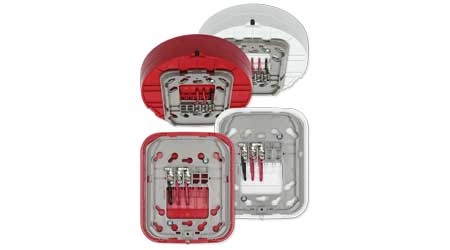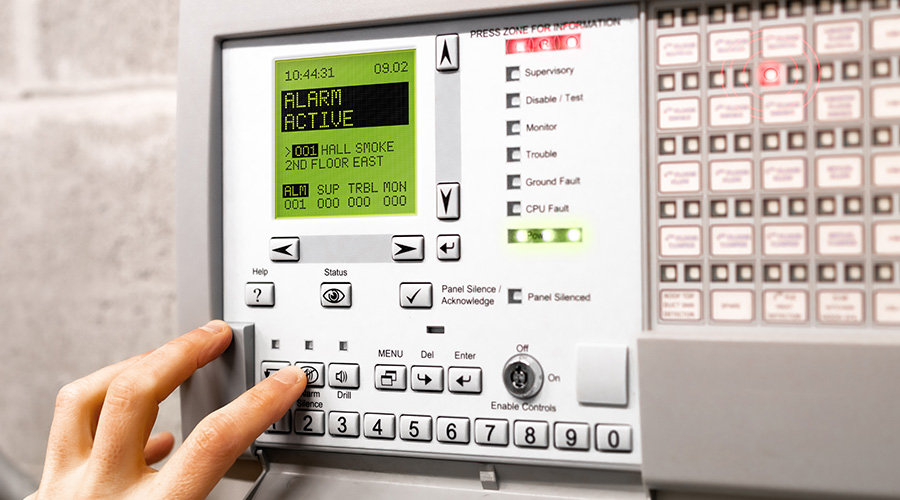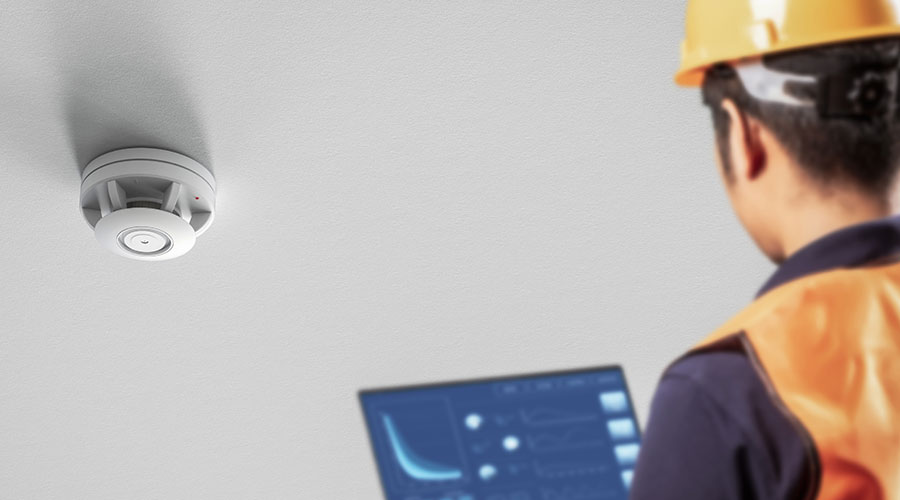3 New Technologies to Consider for Fire Alarm Upgrades
These advances may bring huge advantages with little initial cost.
By Wayne D. Moore and Larry D. Rietz
When you are planning to upgrade or replace an existing fire alarm system, it would be inappropriate to assume you cannot afford to add better features and functionality. In fact, it would be unfortunate not to take advantage of technological advances in the fire alarm market such as wireless technology, supervising station reporting technology, and new loudspeaker technology for voice systems. A close look at these features shows that using new technology often can provide many advantages with relatively similar costs to continuing to use older technology.
1. Wireless fire alarm technology
The world today is full of all types of wireless technology. The fire alarm market has been slow in adopting wireless technology due to the strict nature of prescriptive code and listing requirements for life safety equipment. However, over the last 10 years, advances in wireless fire- alarm equipment have brought new products in the marketplace, including a full range of transmitters, initiating devices, and even notification appliances. The use of long-lasting lithium-ion batteries is one of the keys to making wireless fire alarm devices and appliances a viable commercial alternative to wired units.
On the surface, it would appear that a completely, or mostly, wireless fire alarm installation would present some significant cost savings to the owner. And from an installation cost perspective, many times it does. However, the nature of the existing built environment and modern LEED-certified construction techniques can present some challenges to the widespread use of wireless fire alarm technology. Fire-rated concrete walls, floors and ceilings, along with glass and steel construction, can block or weaken wireless signal strength, leading to challenges maintaining the required communication protocols with life-safety equipment.
As an example, fire sprinkler zone valves are often installed in exit stairwells. As smokeproof enclosures, these are often constructed of steel and concrete, and wireless signals may be weakened or even prevented from constant communication with the wireless fire alarm monitoring equipment located within them. Although such challenges can be overcome with a solid, competent design, often problems are only discovered during, or even after, system commissioning takes place. At that point, installation changes are much more expensive to make.
Wireless fire alarm technology should be used surgically, for very specific situations. Often, this may be limited to historically or architecturally sensitive areas, or where wireless technology represents the only option for a specific situation. In such cases, the advantages of the wireless technology can be enhanced with a proper design of the location of transmitters and repeaters and by verifying compliance with manufacturers’ installation requirements. A robust test, inspection, and maintenance program is also very important, as batteries must be replaced and signal strength must be maintained for the life of the device.
2. New supervising station reporting technologies
Perhaps you have heard that the plain old phone line is dead? And you are right. Thousands and thousands of existing fire- alarm systems use analog “landline” phone lines to communicate with remote supervising stations or central stations via digital alarm communicating transmitters (DACTs). Although such technology has worked well for many years, it has most definitely changed. For the last several cycles of NFPA 72, the National Fire Alarm and Signaling Code, supervising station requirements have allowed, and even preferred, the use of wireless mesh radio, cellular, and internet protocol (IP)-based technologies. These technologies can allow significant improvements in both performance and cost.
Maintaining typical landlines (usually two) represents a significant facility cost each month. With increasing frequency, phone providers are working to eliminate landlines, forcing you to find a different solution. These solutions can be provided with a little upfront cost, but with a lifetime of monthly savings in most cases. Moving supervising station reporting to a new technology can be very cost effective and advantageous from a performance standpoint.
For instance, one facility used a standard DACT connection via two phone lines to report to the supervising station. After an alarm was activated at the fire alarm control unit, the signal was transmitted to the supervising station and ultimately to the fire department for response. This process took an average of 90 seconds. However, the facility discontinued use of their landlines, and switched to the use of a wireless mesh radio system. This reduced the time it took to get the alarm signal directly to the fire department to about 8 seconds. Although this may not be typical, it does represent the significant advantage in performance such a system can provide. Also, the facility no longer has to support the cost of phone lines every month.
Upgrading your supervising station reporting technology requires a proper design. Research should be performed with your current and other monitoring providers to see what technologies may work best in your local area and what receiving equipment the supervising station has available. If cellular or radio technologies are to be used, signal strength and antenna locations need to be coordinated. And, of course, any change in technology should be thoroughly tested to confirm all types of signal transmission and signal receipt.
3. New loudspeaker technologies
Voice fire alarm systems have been in active use for more than 40 years. Some continue to work quite well, while many others have been replaced or need replacement or upgrading. Over the last five years or so, there has been an influx of voice systems from various manufacturers to meet the need of an increasing number of code requirements for voice systems. However, other than the switch from analog to digital processing equipment, much of the head-end processing equipment and amplifiers have not changed in many years.
In some ways this is true of loudspeaker technology. However, technology improvements, or perhaps better said, technology expansion from the commercial sound and communications world to the fire-alarm world, has increased the intelligibility options available.
There are some commonalities between fire alarm loudspeakers from almost every manufacturer. Using a 4-inch paper speaker cone is cost effective and places the loudspeaker in a much smaller package. The loudspeaker can usually be installed on a 4-inch or 4 11/16-inch backbox, with or without an extension ring for ease of installation. Usually two different voltages are available (25 VRMS or 70.7 VRMS) to allow some universality with the chosen amplifier and wiring length. The frequency of the loudspeaker is almost always 400 to 4,000 Hz. Power is usually provided by 4 taps from 1/4 Watt to 2 Watts, but occasionally extends from 1/8 Watt to 4 Watts in eight steps of power. The 25 VRMS options may be different than the 70 VRMS options on the same loudspeaker.
Additionally, all UL-listed fire- alarm loudspeakers are built with the understanding that a supervisory voltage will be monitoring circuit integrity of the loudspeaker circuit when the circuit is not in use. This is usually done with a blocking diode and marks a significant difference from commercial audio speakers, which is why they are usually not interchangeable.
Other developments are changing the status quo of fire-alarm loudspeakers. First, there is a movement from regular to high-fidelity loudspeakers. This is highly important. Moving to high-fidelity involves increasing the speaker frequency, expanding from 400 to 4,000 Hz to 300 to 8,000 Hz, or in some cases even 200 to 10,000 Hz. Keep in mind that a large portion (more than 30 percent, roughly speaking) of the human speech zone is above the 4,000 Hz range. The move to high-fidelity is occurring while continuing to use the 4-inch speaker cone (thus keeping the small real estate required) and maintaining all of the other speaker power and voltage options.
Some caution is appropriate in this regard, as “high-fidelity” is often used as a marketing term and may reflect so-called high-fidelity only at a certain frequency, like 520 Hz, and may not indicate an increase in the actual full frequency range of the loudspeaker for human speech. Verify the details on the loudspeaker data sheet.
Another technology improvement is the increase in loudspeaker size. Moving from a 4-inch to an 8-inch loudspeaker cone creates a better bandwidth performance and thus increases intelligibility. The larger cone increases the loudspeaker frequency response that can deliver the seven octaves of human speech much better than a 4-inch cone. With this improvement comes additional power taps on the loudspeaker, providing greater field flexibility for adjustments to output levels. Obviously, an 8-inch loudspeaker will take up more real estate than a 4-inch device, but the intelligibility increase may be more than worth it. Also, some of these larger loudspeakers may only work at 70 VRMS or higher.
Clearly you must do your research and select the correct loudspeaker for the correct application. This is especially true in large or highly reverberant spaces where intelligibility is difficult to obtain. Using UL-listed fire alarm loudspeakers that are omni-directional can greatly increase intelligibility, while reducing the number of regular fire alarm loudspeakers by 50 to 1 or more. This represents a significant savings in material and installation labor, wiring and battery backup, as well as long-term inspection and maintenance savings.
In large or highly reverberant spaces with sensitive aesthetics, the latest addition to the UL-listed fire alarm loudspeaker market may meet the need. Line-array loudspeakers have long been used in the commercial sound and communications industry, and now that technology is available for the fire alarm/emergency communication system marketplace.
A line-array loudspeaker controls the vertical dispersion of the sound, placing the sound where it is needed most — at the listener’s ears — without adding to harmful reverberation and echoes. These line-array loudspeakers can be installed so as to negate the need for many regular fire-alarm loudspeakers, again resulting in significant savings in material and installation labor.
Of course, the new technologies just described may not be applicable to every opportunity. Decisions about upgrades should be based on an analysis of the specific facility conditions and organizational objectives, while designers should keep their minds open to new technology that is available. Whether you seek to upgrade your fire- alarm system or fully replace it, implementing the new technology available to you will ensure improved fire protection and at the same time keep your investment costs to a minimum. In all cases, hiring the appropriate fire- protection professional will assist you in making the right choices for your specific needs.
Wayne D. Moore (wmoore@jensenhughes.com), PE, is vice president and technical fellow for JensenHughes. Larry D. Rietz (lrietz@jensenhughes.com), SET, is director, Denver, for Jensen Hughes.
Related Topics:












